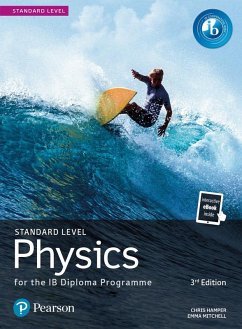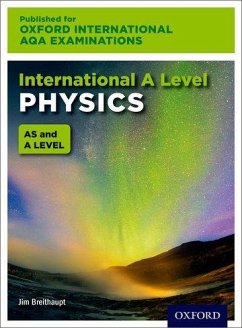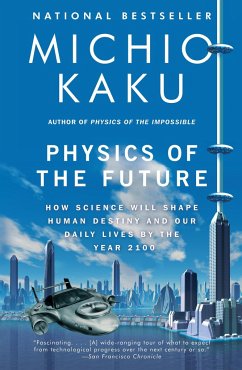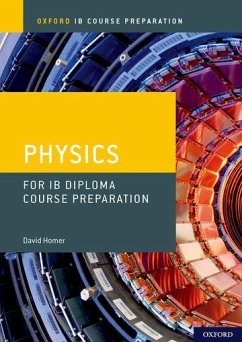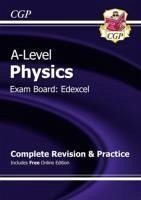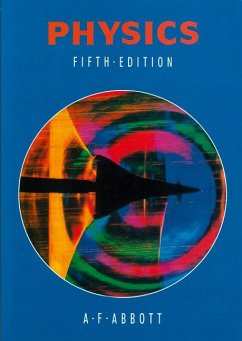
Physics for Scientists & Engineers with Modern Physics Pearson New International Edition, plus MasteringPhysics without eText
Versandkostenfrei!
Versandfertig in 2-4 Wochen
105,99 €
inkl. MwSt.

PAYBACK Punkte
53 °P sammeln!
For the calculus-based General Physics course primarily taken by engineers and science majors (including physics majors).
This long-awaited and extensive revision maintains Giancoli's reputation for creating carefully crafted, highly accurate and precise physics texts. Physics for Scientists and Engineers combines outstanding pedagogy with a clear and direct narrative and applications that draw the student into the physics. The new edition also features an unrivaled suite of media and on-line resources that enhance the understanding of physics.
This book is written for students. It aims to explain physics in a readable and interesting manner that is accessible and clear, and to teach students by anticipating their needs and difficulties without oversimplifying.
Physics is a description of reality, and thus each topic begins with concrete observations and experiences that students can directly relate to. We then move on to the generalizations and more formal treatment of the topic. Not only does this make the material more interesting and easier to understand, but it is closer to the way physics is actually practiced.
Features + Benefits
Pedagogical Features
Greater clarity: No topic, no paragraph in this book was overlooked in the search to improve the clarity of the presentation. Many changes and clarifications have been made, both small and not so small. One goal has been to eliminate phrases and sentences that may slow down the principle argument: keep to the essentials at first, give the elaborations later.
Color is used pedagogically to bring out the physics. Different types of vectors are given different colors. This book has been printed in 5 colors (5 passes through the presses) to provide better variety and definition for illustrating vectors and other concepts such as fields and rays. The photographs opening each Chapter, some of which have vectors superimposed on them, have been chosen so that the accompanying caption can be a sort of summary of the Chapter.
The wide range of Applications have been carefully chosen and integrated into the text so as not to interfere with the development of the physics, but rather to illuminate it.Some serve only as examples of physical principles, some are treated in greater depth. To make it easy to spot the Applications, a Physics Applied marginal note is placed in the margin. A list of Applications shall appear after the Table of Contents.
Problem-Solving Marginal Notes are included throughout the Chapters to emphasize key Problem Solving strategies.
Problem-Solving Boxes, found throughout the book, outline a step-by-step approach to get students thinking about and involved in the problem at hand.
Step-by-Step Examples follow most Problem Solving Boxes with the next Example being worked step-by-step, following the steps of the preceding Problem Solving Box to show students how this tool can be
Estimation Examples help students develop skills for making order-of-magnitude estimates, even when data is scarce, or when you might never have guessed any result was possible.
CONTENTS OF VOLUME 1
APPLICATIONS LIST xii
PREFACE xiv
AVAILABLE SUPPLEMENTS AND MEDIA xxii
NOTES TO STUDENTS (AND INSTRUCTORS) ON THE FORMAT xxiv
COLOR USE: VECTORS, FIELDS, AND SYMBOLS xxv
CHAPTER1: INTRODUCTION, MEASUREMENT, ESTIMATING
1—1 The Nature of Science
1—2 Models, Theories, and Laws
1—3 Measurement and Uncertainty; Significant Figures
1—4 Units, Standards, and the SI System
1—5 Converting Units
1—6 Order of Magnitude: Rapid Estimating
*1—7 Dimensions and Dimensional Analysis
SUMMARY
QUESTIONS
PROBLEMS
GENERAL PROBLEMS
CHAPTER 2: DESCRIBING MOTION: KINEMATICS IN ONE DIMENSION
2—1 Reference Frames and Displacement
2—2 Average Velocity
2—3 Instantaneous Velocity
2—4 Acceleration
2—5 Motion at Constant Acceleration
2—6 Solving Problems
2—7 Freely Falling Objects
*2—8 Variable Acceleration; Integral Calculus
*2—9 Graphical Analysis and Numerical Integration
SUMMARY
QUESTIONS
PROBLEMS
GENERAL PROBLEMS
CHAPTER 3: KINEMATICS IN TWO OR THREE DIMENSIONS; VECTORS
3—1 Vectors and Scalars
3—2 Addition of Vectors–Graphical Methods
3—3 Subtraction of Vectors, and Multiplication of a Vector by a Scalar
3—4 Adding Vectors by Components
3—5 Unit Vectors
3—6 Vector Kinematics
3—7 Projectile Motion
3—8 Solving Problems Involving Projectile Motion
3—9 Relative Velocity
SUMMARY
QUESTIONS
PROBLEMS
GENERAL PROBLEMS
CHAPTER 4: DYNAMICS: NEWTON’S LAWS OF MOTION
4—1 Force
4—2 Newton’s First Law of Motion
4—3 Mass
4—4 Newton’s Second Law of Motion
4—5 Newton’s Third Law of Motion
4—6 Weight–the Force of Gravity; and the Normal Force
4—7 Solving Problems with Newton’s Laws: Free-Body Diagrams
4—8 Problem Solving–A General Approach
SUMMARY
QUESTIONS
PROBLEMS
GENERAL PROBLEMS
CHAPTER 5: USING NEWTON’S LAWS: FRICTION, CIRCULAR MOTION, DRAG FORCES
5—1 Applications of Newton’s Laws Involving Friction
5—2 Uniform Circular Motion–Kinematics
5—3 Dynamics of Uniform Circular Motion
5—4 Highway Curves: Banked and Unbanked
*5—5 Nonuniform Circular Motion
*5—6 Velocity-Dependent Forces: Drag and Terminal Velocity
SUMMARY
QUESTIONS
PROBLEMS
GENERAL PROBLEMS
CHAPTER 6: GRAVITATION AND NEWTON’S6 SYNTHESIS
6—1 Newton’s Law of Universal Gravitation
6—2 Vector Form of Newton’s Law of Universal Gravitation
6—3 Gravity Near the Earth’s Surface; Geophysical Applications
6—4 Satellites and “Weightlessness”
6—5 Kepler’s Laws and Newton’s Synthesis
*6—6 Gravitational Field
6—7 Types of Forces in Nature
*6—8 Principle of Equivalence; Curvature of Space; Black Holes
SUMMARY
QUESTIONS
PROBLEMS
GENERAL PROBLEMS
CHAPTER 7: WORK AND ENERGY
7—1 Work Done by a Constant Force
7—2 Scalar Product of Two Vectors
7—3 Work Done by a Varying Force
7—4 Kinetic Energy and the Work-Energy Principle
SUMMARY
QUESTIONS
PROBLEMS
GENERAL PROBLEMS
CHAPTER 8: CONSERVATION OF ENERGY
8—1 Conservative and Nonconservative Forces
8—2 Potential Energy
8—3 Mechanical Energy and Its Conservation
8—4 Problem Solving Using Conservation of Mechanical Energy
8—5 The Law of Conservation of Energy
8—6 Energy Conservation with Dissipative Forces: Solving Problems
8—7 Gravitational Potential Energy and Escape Velocity
8—8 Power
*8—9 Potential Energy Diagrams; Stable and Unstable Equilibrium
SUMMARY
QUESTIONS
PROBLEMS
GENERAL PROBLEMS
CHAPTER 9: LINEAR MOMENTUM
9—1 Momentum and Its Relation to Force
9—2 Conservation of Momentum
9—3 Collisions and Impulse
9—4 Conservation of Energy and Momentum in Collisions
9—5 Elastic Collisions in One Dimension
9—6 Inelastic Collisions
9—7 Collisions in Two or Three Dimensions
9—8 Center of Mass (CM)
9—9 Center of Mass and Translational Motion
*9—10 Systems of Variable Mass; Rocket Propulsion
SUMMARY
QUESTIONS
PROBLEMS
GENERAL PROBLEMS
CHAPTER 10: ROTATIONAL MOTION
10—1 Angular Quantities
10—2 Vector Nature of Angular Quantities
10—3 Constant Angular Acceleration
10—4 Torque
10—5 Rotational Dynamics; Torque and Rotational Inertia
10—6 Solving Problems in Rotational Dynamics
10—7 Determining Moments of Inertia
10—8 Rotational Kinetic Energy
10—9 Rotational Plus Translational Motion; Rolling
*10—10 Why Does a Rolling Sphere Slow Down?
SUMMARY
QUESTIONS
PROBLEMS
GENERAL PROBLEMS
CHAPTER 11: ANGULAR MOMENTUM; GENERAL ROTATION
11—1 Angular Momentum–Object Rotating About a Fixed Axis
11—2 Vector Cross Product; Torque as a Vector
11—3 Angular Momentum of a Particle
11—4 Angular Momentum and Torque for a System of Particles; General Motion
11—5 Angular Momentum and Torque for a Rigid Object
11—6 Conservation of Angular Momentum
*11—7 The Spinning Top and Gyroscope
*11—8 Rotating Frames of Reference; Inertial Forces
*11—9 The Coriolis Effect
SUMMARY
QUESTIONS
PROBLEMS
GENERAL PROBLEMS
CHAPTER 12: STATIC EQUILIBRIUM; ELASTICITY AND FRACTURE
12—1 The Conditions for Equilibrium
12—2 Solving Statics Problems
12—3 Stability and Balance
12—4 Elasticity; Stress and Strain
12—5 Fracture
*12—6 Trusses and Bridges
*12—7 Arches and Domes
SUMMARY
QUESTIONS
PROBLEMS
GENERAL PROBLEMS
CHAPTER 13: FLUIDS
13—1 Phases of Matter
13—2 Density and Specific Gravity
13—3 Pressure in Fluids
13—4 Atmospheric Pressure and Gauge Pressure
13—5 Pascal’s Principle
13—6 Measurement of Pressure; Gauges and the Barometer
13—7 Buoyancy and Archimedes’ Principle
13—8 Fluids in Motion; Flow Rate and the Equation of Continuity
13—9 Bernoulli’s Equation
13—10 Applications of Bernoulli’s Principle: Torricelli, Airplanes, Baseballs, TIA
*13—11 Viscosity
*13—12 Flow in Tubes: Poiseuille’s Equation, Blood Flow
*13—13 Surface Tension and Capillarity
*13—14 Pumps, and the Heart
SUMMARY
QUESTIONS
PROBLEMS
GENERAL PROBLEMS
CHAPTER 14: OSCILLATIONS
14—1 Oscillations of a Spring
14—2 Simple Harmonic Motion
14—3 Energy in the Simple Harmonic Oscillator
14—4 Simple Harmonic Motion Related to Uniform Circul
This long-awaited and extensive revision maintains Giancoli's reputation for creating carefully crafted, highly accurate and precise physics texts. Physics for Scientists and Engineers combines outstanding pedagogy with a clear and direct narrative and applications that draw the student into the physics. The new edition also features an unrivaled suite of media and on-line resources that enhance the understanding of physics.
This book is written for students. It aims to explain physics in a readable and interesting manner that is accessible and clear, and to teach students by anticipating their needs and difficulties without oversimplifying.
Physics is a description of reality, and thus each topic begins with concrete observations and experiences that students can directly relate to. We then move on to the generalizations and more formal treatment of the topic. Not only does this make the material more interesting and easier to understand, but it is closer to the way physics is actually practiced.
Features + Benefits
Pedagogical Features
Greater clarity: No topic, no paragraph in this book was overlooked in the search to improve the clarity of the presentation. Many changes and clarifications have been made, both small and not so small. One goal has been to eliminate phrases and sentences that may slow down the principle argument: keep to the essentials at first, give the elaborations later.
Color is used pedagogically to bring out the physics. Different types of vectors are given different colors. This book has been printed in 5 colors (5 passes through the presses) to provide better variety and definition for illustrating vectors and other concepts such as fields and rays. The photographs opening each Chapter, some of which have vectors superimposed on them, have been chosen so that the accompanying caption can be a sort of summary of the Chapter.
The wide range of Applications have been carefully chosen and integrated into the text so as not to interfere with the development of the physics, but rather to illuminate it.Some serve only as examples of physical principles, some are treated in greater depth. To make it easy to spot the Applications, a Physics Applied marginal note is placed in the margin. A list of Applications shall appear after the Table of Contents.
Problem-Solving Marginal Notes are included throughout the Chapters to emphasize key Problem Solving strategies.
Problem-Solving Boxes, found throughout the book, outline a step-by-step approach to get students thinking about and involved in the problem at hand.
Step-by-Step Examples follow most Problem Solving Boxes with the next Example being worked step-by-step, following the steps of the preceding Problem Solving Box to show students how this tool can be
Estimation Examples help students develop skills for making order-of-magnitude estimates, even when data is scarce, or when you might never have guessed any result was possible.
CONTENTS OF VOLUME 1
APPLICATIONS LIST xii
PREFACE xiv
AVAILABLE SUPPLEMENTS AND MEDIA xxii
NOTES TO STUDENTS (AND INSTRUCTORS) ON THE FORMAT xxiv
COLOR USE: VECTORS, FIELDS, AND SYMBOLS xxv
CHAPTER1: INTRODUCTION, MEASUREMENT, ESTIMATING
1—1 The Nature of Science
1—2 Models, Theories, and Laws
1—3 Measurement and Uncertainty; Significant Figures
1—4 Units, Standards, and the SI System
1—5 Converting Units
1—6 Order of Magnitude: Rapid Estimating
*1—7 Dimensions and Dimensional Analysis
SUMMARY
QUESTIONS
PROBLEMS
GENERAL PROBLEMS
CHAPTER 2: DESCRIBING MOTION: KINEMATICS IN ONE DIMENSION
2—1 Reference Frames and Displacement
2—2 Average Velocity
2—3 Instantaneous Velocity
2—4 Acceleration
2—5 Motion at Constant Acceleration
2—6 Solving Problems
2—7 Freely Falling Objects
*2—8 Variable Acceleration; Integral Calculus
*2—9 Graphical Analysis and Numerical Integration
SUMMARY
QUESTIONS
PROBLEMS
GENERAL PROBLEMS
CHAPTER 3: KINEMATICS IN TWO OR THREE DIMENSIONS; VECTORS
3—1 Vectors and Scalars
3—2 Addition of Vectors–Graphical Methods
3—3 Subtraction of Vectors, and Multiplication of a Vector by a Scalar
3—4 Adding Vectors by Components
3—5 Unit Vectors
3—6 Vector Kinematics
3—7 Projectile Motion
3—8 Solving Problems Involving Projectile Motion
3—9 Relative Velocity
SUMMARY
QUESTIONS
PROBLEMS
GENERAL PROBLEMS
CHAPTER 4: DYNAMICS: NEWTON’S LAWS OF MOTION
4—1 Force
4—2 Newton’s First Law of Motion
4—3 Mass
4—4 Newton’s Second Law of Motion
4—5 Newton’s Third Law of Motion
4—6 Weight–the Force of Gravity; and the Normal Force
4—7 Solving Problems with Newton’s Laws: Free-Body Diagrams
4—8 Problem Solving–A General Approach
SUMMARY
QUESTIONS
PROBLEMS
GENERAL PROBLEMS
CHAPTER 5: USING NEWTON’S LAWS: FRICTION, CIRCULAR MOTION, DRAG FORCES
5—1 Applications of Newton’s Laws Involving Friction
5—2 Uniform Circular Motion–Kinematics
5—3 Dynamics of Uniform Circular Motion
5—4 Highway Curves: Banked and Unbanked
*5—5 Nonuniform Circular Motion
*5—6 Velocity-Dependent Forces: Drag and Terminal Velocity
SUMMARY
QUESTIONS
PROBLEMS
GENERAL PROBLEMS
CHAPTER 6: GRAVITATION AND NEWTON’S6 SYNTHESIS
6—1 Newton’s Law of Universal Gravitation
6—2 Vector Form of Newton’s Law of Universal Gravitation
6—3 Gravity Near the Earth’s Surface; Geophysical Applications
6—4 Satellites and “Weightlessness”
6—5 Kepler’s Laws and Newton’s Synthesis
*6—6 Gravitational Field
6—7 Types of Forces in Nature
*6—8 Principle of Equivalence; Curvature of Space; Black Holes
SUMMARY
QUESTIONS
PROBLEMS
GENERAL PROBLEMS
CHAPTER 7: WORK AND ENERGY
7—1 Work Done by a Constant Force
7—2 Scalar Product of Two Vectors
7—3 Work Done by a Varying Force
7—4 Kinetic Energy and the Work-Energy Principle
SUMMARY
QUESTIONS
PROBLEMS
GENERAL PROBLEMS
CHAPTER 8: CONSERVATION OF ENERGY
8—1 Conservative and Nonconservative Forces
8—2 Potential Energy
8—3 Mechanical Energy and Its Conservation
8—4 Problem Solving Using Conservation of Mechanical Energy
8—5 The Law of Conservation of Energy
8—6 Energy Conservation with Dissipative Forces: Solving Problems
8—7 Gravitational Potential Energy and Escape Velocity
8—8 Power
*8—9 Potential Energy Diagrams; Stable and Unstable Equilibrium
SUMMARY
QUESTIONS
PROBLEMS
GENERAL PROBLEMS
CHAPTER 9: LINEAR MOMENTUM
9—1 Momentum and Its Relation to Force
9—2 Conservation of Momentum
9—3 Collisions and Impulse
9—4 Conservation of Energy and Momentum in Collisions
9—5 Elastic Collisions in One Dimension
9—6 Inelastic Collisions
9—7 Collisions in Two or Three Dimensions
9—8 Center of Mass (CM)
9—9 Center of Mass and Translational Motion
*9—10 Systems of Variable Mass; Rocket Propulsion
SUMMARY
QUESTIONS
PROBLEMS
GENERAL PROBLEMS
CHAPTER 10: ROTATIONAL MOTION
10—1 Angular Quantities
10—2 Vector Nature of Angular Quantities
10—3 Constant Angular Acceleration
10—4 Torque
10—5 Rotational Dynamics; Torque and Rotational Inertia
10—6 Solving Problems in Rotational Dynamics
10—7 Determining Moments of Inertia
10—8 Rotational Kinetic Energy
10—9 Rotational Plus Translational Motion; Rolling
*10—10 Why Does a Rolling Sphere Slow Down?
SUMMARY
QUESTIONS
PROBLEMS
GENERAL PROBLEMS
CHAPTER 11: ANGULAR MOMENTUM; GENERAL ROTATION
11—1 Angular Momentum–Object Rotating About a Fixed Axis
11—2 Vector Cross Product; Torque as a Vector
11—3 Angular Momentum of a Particle
11—4 Angular Momentum and Torque for a System of Particles; General Motion
11—5 Angular Momentum and Torque for a Rigid Object
11—6 Conservation of Angular Momentum
*11—7 The Spinning Top and Gyroscope
*11—8 Rotating Frames of Reference; Inertial Forces
*11—9 The Coriolis Effect
SUMMARY
QUESTIONS
PROBLEMS
GENERAL PROBLEMS
CHAPTER 12: STATIC EQUILIBRIUM; ELASTICITY AND FRACTURE
12—1 The Conditions for Equilibrium
12—2 Solving Statics Problems
12—3 Stability and Balance
12—4 Elasticity; Stress and Strain
12—5 Fracture
*12—6 Trusses and Bridges
*12—7 Arches and Domes
SUMMARY
QUESTIONS
PROBLEMS
GENERAL PROBLEMS
CHAPTER 13: FLUIDS
13—1 Phases of Matter
13—2 Density and Specific Gravity
13—3 Pressure in Fluids
13—4 Atmospheric Pressure and Gauge Pressure
13—5 Pascal’s Principle
13—6 Measurement of Pressure; Gauges and the Barometer
13—7 Buoyancy and Archimedes’ Principle
13—8 Fluids in Motion; Flow Rate and the Equation of Continuity
13—9 Bernoulli’s Equation
13—10 Applications of Bernoulli’s Principle: Torricelli, Airplanes, Baseballs, TIA
*13—11 Viscosity
*13—12 Flow in Tubes: Poiseuille’s Equation, Blood Flow
*13—13 Surface Tension and Capillarity
*13—14 Pumps, and the Heart
SUMMARY
QUESTIONS
PROBLEMS
GENERAL PROBLEMS
CHAPTER 14: OSCILLATIONS
14—1 Oscillations of a Spring
14—2 Simple Harmonic Motion
14—3 Energy in the Simple Harmonic Oscillator
14—4 Simple Harmonic Motion Related to Uniform Circul
For the calculus-based General Physics course primarily taken by engineers and science majors (including physics majors). This long-awaited and extensive revision maintains Giancoli's reputation for creating carefully crafted, highly accurate and precise physics texts. Physics for Scientists and Engineers combines outstanding pedagogy with a clear and direct narrative and applications that draw the student into the physics. The new edition also features an unrivaled suite of media and on-line resources that enhance the understanding of physics. This book is written for students. It aims to explain physics in a readable and interesting manner that is accessible and clear, and to teach students by anticipating their needs and difficulties without oversimplifying. Physics is a description of reality, and thus each topic begins with concrete observations and experiences that students can directly relate to. We then move on to the generalizations and more formal treatment of the topic. Not only does this make the material more interesting and easier to understand, but it is closer to the way physics is actually practiced.
Dieser Artikel kann nur an eine deutsche Lieferadresse ausgeliefert werden.




